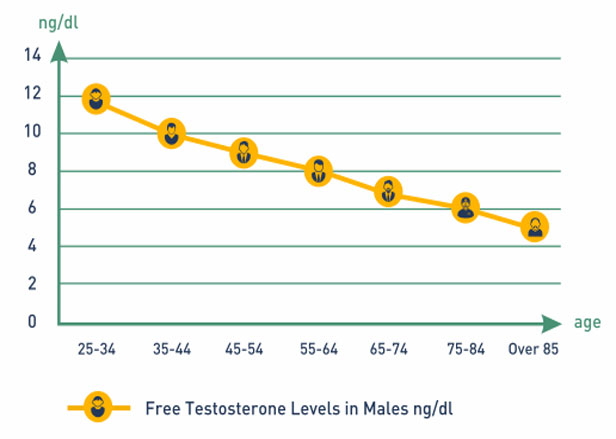What Does Free Testosterone Levels Mean?
Free testosterone means the amount of unattached testosterone in your blood. As testosterone is secreted into the bloodstream, some of it attaches to one of two proteins:
- Albumin
- SHBG – sex hormone binding globulin
What does not attach to these proteins can be ascertained by checking free testosterone levels through blood analysis. Bioavailable testosterone consists of a combination of both free and serum albumin-bound testosterone, available for crucial tissue uptake.
SHBG bound testosterone is inactive and cannot enter and activate cellular androgen receptors, and, therefore, cannot provide the necessary immediate effects that testosterone is required to bring to the body. What actually occurs here is that the SHBG molecule wraps around and encapsulates the free testosterone and transports it through the blood stream to its final destination, such as a muscle. Once it arrives at the destination point, the SHBG separates from the testosterone, allowing it to be once again free and exert its activity to perform its function. Higher SHBG levels mean lower free testosterone levels. For that reason, it is recommended that free testosterone levels in men and women be checked as part of a full blood workup to detect Low T.
Checking testosterone free and total levels is crucial for the doctor to make an accurate diagnosis. Some people who have had borderline to low total testosterone levels have been diagnosed with Low T when free testosterone has not been checked – only later to find out that these levels were normal. Conversely, some men, especially of later years, have had average total testosterone but low free testosterone and have gone without treatment when the free levels were not checked.
Remember, total testosterone measures all three types, while free testosterone measures what is available in the body for use. It is also essential to point out that the normal total and free testosterone range scale in use today varies from lab to lab and throughout medical science. That is why doctors use a combination approach to diagnosing Low T – blood test results and symptomology.
What Are Normal Free Testosterone Levels?
Total testosterone levels decline in healthy men, on average, 30% between age 25 and 75. As a man ages, SHBG levels increase, causing normal free testosterone levels to drop even further – on average 50%. This significant decrease is believed to be the cause of the symptoms associated with Low T in later years.
| Age | Free Testosterone Levels by Age |
| 25-34 | 12.3 |
| 35-44 | 10.3 |
| 45-54 | 9.1 |
| 55-64 | 8.3 |
| 65-74 | 6.9 |
| 75-84 | 6.0 |
| 85-100 | 5.4 |
The free testosterone normal range for adult males is 5 – 21 ng/dL, however, the chart below shows how the average amount can change over the years:
A man whose blood test results show less than 5 ng/dL at any age is considered to have low free testosterone, and will typically be diagnosed with Low T. The chart above shows what has been detected as the average level for each different age group.
High free testosterone, in both men and women, can lead to oily skin, acne, facial and body hair growth, increased breast tissue, and infertility. Women can also suffer from PCOS – polycystic ovarian syndrome.
After age 60, 1 out of every 5 men may have total testosterone levels below the normal range. That does not mean they are not suffering from Low T because even those at the lower end of the normal scale can have symptoms that would benefit from testosterone treatment.
How to Increase Free Testosterone

How well these methods will work also depends on how low the free testosterone level in the body is at the start of these alterations. Someone dealing with severe Low T will often need to do more than change his or her lifestyle, and that involves medical testosterone replacement therapy.
Here are different ways to increase free testosterone:
- Hormone replacement therapy – testosterone treatment can be beneficial for Low T symptoms. TRT – testosterone replacement therapy – should only be used when prescribed by a doctor because symptoms of Low T are present, and the blood test results show that a person is dealing with either low levels of testosterone or borderline low to normal levels.
- Consume a healthy balanced diet – try some of the food choices that are highlighted in “Foods That Increase Testosterone” on this website.
- Get adequate sleep – 7 to 9 hours each night to increase free testosterone levels.
- Exercise with purpose – Vigorous aerobic exercise and high-intensity, slow moving weight bearing workouts aid in the release of testosterone. As with most things, avoid excess because too much exercise can be detrimental and cause increased levels of cortisol release due to excess stress on the body.
- Reduce stress – while we are on this subject, it is essential to reduce stress to lower the amount of cortisol released into the bloodstream. This will interfere with adequate free testosterone.
- Lose weight – excess weight on the body decreases testosterone production. Even a slight loss of belly fat can have beneficial results.
Most people who are diagnosed with Low T will have to work closely with a hormone replacement specialist to raise their testosterone levels back to their ideal state. This most often requires some form of TRT. Bioidentical testosterone therapy has been shown to be extremely safe and very effective at reversing the symptoms associated with Low T.
Free Testosterone vs. Total Testosterone
Just as there is a need to measure both LDL and HDL cholesterol to get an accurate assessment of a person’s cholesterol levels, it is essential to look at both free and total testosterone before diagnosing Low T and offering treatment.
In a comparison of free testosterone vs. total testosterone, while total T offers the bigger picture, especially when taking into consideration if follicle-stimulating hormone (FSH) and luteinizing hormone (LH) levels are in line, free T leans more to a problem with SHBG.
There are two types of Low T or hypogonadism:
- Primary hypogonadism
- Secondary hypogonadism
In primary hypogonadism, a person will have low total serum testosterone and elevated FSH and LH. In secondary hypogonadism, FSH and LH could be either normal or elevated. Individuals who are older or overweight will benefit from testing their free testosterone levels pg/ml in order to determine if SHBG levels are providing a false total T reading.
Another reason why we test free testosterone levels in females and males is to also check for a condition called estrogen dominance. An estradiol blood analysis done at the same time as testosterone testing will show if the body is converting too much free testosterone into estradiol (estrogen). If this is occurring, both total and free testosterone levels could decline.
What happens during estrogen dominance?
A process called aromatization occurs when the enzyme aromatase is secreted by belly fat. The more abdominal fat a person has, the higher the concentration of aromatase in the bloodstream. Once secreted, this enzyme goes to work seeking out free testosterone before it delivers its signal or message by binding with testosterone receptors on the body’s tissues. Aromatase then converts the free testosterone into estradiol before it can do its job.
It is not only important to increase free testosterone for a person dealing with Low T, but also to stop the conversion process with an aromatase inhibitor if estrogen dominance is an issue.
National HRT is a hormone replacement clinic that helps men and women restore balance to their bodies and lives through safe, legal forms of hormone replacement. We offer a full range of diagnostic testing, guidance, support, and treatment options. Contact us by phone or through the form here for a free and confidential consultation with a medical advisor.
- Free testosterone: clinical utility and important analytical aspects of measurement.Shea JL1, Wong PY2 Chen Y Adv Clin Chem. 2014;63:59-84.
- EverlyWell
- Low Free Testosterone Is Associated with Hypogonadal Signs and Symptoms in Men with Normal Total Testosterone Leen Antonio Frederick C. W. Wu Terence W. O’Neill Stephen R. Pye Tomas B. Ahern Michaël R. Laurent Ilpo T. Huhtaniemi Michael E. J. Lean Brian G. Keevil Giulia Rastrelli Gianni Forti György Bartfai Felipe F. Casanueva Krzysztof Kula Margus Punab Aleksander Giwercman Frank Claessens Brigitte Decallonne Dirk Vanderschueren the European Male Ageing Study Study Group The Journal of Clinical Endocrinology & Metabolism, Volume 101, Issue 7, 1 July 2016, Pages 2647–2657
- Willem de Ronde, Yvonne T. van der Schouw, Huibert A.P. Pols, Louis J.G. Gooren, Majon Muller, Diederick E. Grobbee, Frank H. de Jong Published August 2005
- Endocrine news



